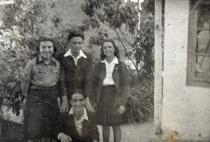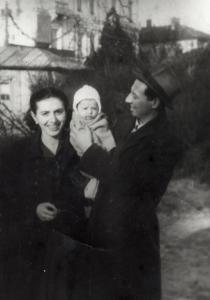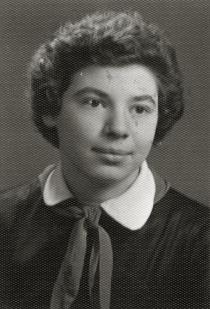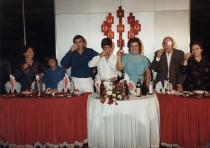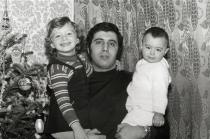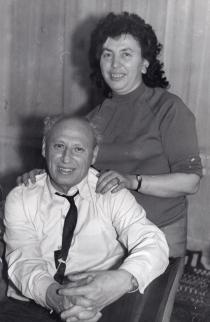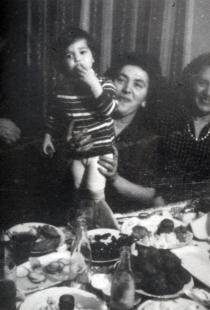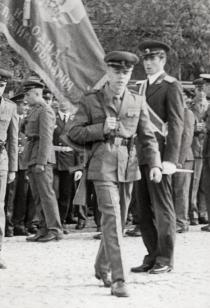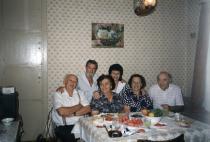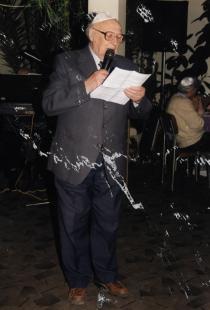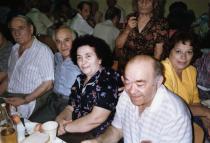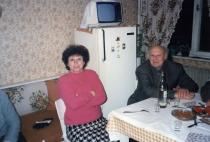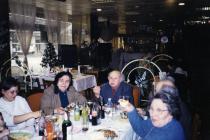
Bela Menahem Ishakh
Ruse
Bulgaria
Interviewer: Patricia Nikolova
Date of interview: November 2004
Bela Ishakh is a pleasant person with interesting viewpoints on life. Her wisdom that was gained through experience over the years is expressed in many valuable pieces of advice, sayings and observations that Bela is pleased to share with others. Her hospitable home, situated near the Danube, invokes the feeling of orderliness in life and in the family of Bela Ishakh. The sensation that she is the mistress of the house may easily evolve into the sensation that she is the mistress of the situation and also the family ruler. In this respect, it will not be incorrect to say that the position Bela Ishakh has in her family determines the atmosphere of matriarchate.
I am a descendant of a Sephardi 1 family, but unfortunately, I don’t know many specific facts, or any emblematic family stories connected with my ancestors. What I know for sure is that they lived in Silistra, a town near the Danube River, where I was born, too.
My grandparents’ paternal and maternal parents are not known to me. I know only that the whole family was burned in the death camps in 1943 after the deportation of Macedonian Jews 2. I don’t know when the parents of my parents were born, and I can’t say anything about their life before their coming to live in Bulgaria. I have no idea of what their home might have looked like. I only know they were not rich.
My parents were called Menahem and Roza Alfandari. They were born in Istanbul and Silistra, respectively. My father was born in 1889 and died in 1969, and my mother was born in 1903 and died in 1968. They were buried in the Jewish cemetery in one and the same grave. Dad was in the trade with grain crops, wheat, rice, and Mom had always been a housewife. They had elementary education.
My parents were religious people and this was what my children inherited, too, since my father and mother actively helped me with the bringing-up of my own children. We attended services at the synagogue quite regularly, especially on the high Jewish holidays such as Yom Kippur, Pesach, Chanukkah, Lag ba-Omer, Purim, and Rosh Hashanah. My favorite holiday was Pesach. I liked the history of this holiday, especially the lesson of this holiday, which was for me that the Jewish people have been united because of their faith and the strength of this faith.
We spoke Ladino 3 at home, but of course we could communicate in Bulgarian when the situation required it. We used to read non-religious books mainly, secular novels by Mayne Reid [(1818-1883): Irish-American novelist] and others, and after that Marxist literature, dialectical materialism. We, the children read these books.
We lived a simple life in a tidy, humble house in the Jewish neighborhood of Ruse. The house had two rooms and a kitchen. We used wood for heating. There was no electricity then. We had oil lamps. Despite the poverty of my childhood, I cannot complain because I felt good.
I was born in 1925 in the beautiful town of Silistra, near the Danube River. I am a hairdresser by profession. I have two sisters whom I love very much. The first one is Victoria Markus [nee Alfandari] and the second is Ester Alfandari. Both of them are now in Israel. I was the youngest of all the three, but I was the first to marry.
During the totalitarian period my sister Ester lived in Sofia and immigrated to Israel in 1999. Now she lives in Rishon Le Zion. She is married to David Alfandari, who worked as a textile designer when he lived in Bulgaria. They are not religious. Their son, Simon Alfandari, is a doctor. At present, Ester and David are pensioners.
Victoria lived in Ruse together with her husband Leon Markus and after his death in 2002 she moved to Israel – to stay with her son Avram Markus. They live in Kiryat Yam. They are not religious, either.
As a child, I attended the Jewish nursery and the Jewish school in Ruse. The Jewish school then started when the kids were first-graders and ended when they completed their seventh school year. After that, I graduated from the Jewish school in Ruse. Adon [‘Sir’ in Ivrit] Yosif Safra was our teacher in Ivrit. He was a favorite with us because he was very intelligent and nice. I didn’t hate any of the subjects at school, I didn’t need private lessons in any of them, and I didn’t play any musical instrument.
We moved to live in Ruse when I was still very young. I remember that Ruse always had nice markets. Villagers from the nearby settlements came to sell their goods and the citizens crowded to buy things. We had a big and a small market there. We preferred the small one. Tuesdays and Fridays were the market days. All tradesmen there were favorites with us.
In the Jewish quarter on David, Vidin, Klementina, Gurko, Dondukov and Korsakov Streets, where the Jewish population lived, there were only small houses to see. The relationships between the poor and rich Jews were regulated by the Jewish community that collected funds from the rich Jews to give them to the poor.
I’d like to tell you in brief the history of Jews in the town of Ruse, known in the past as Ruscuk [in Turkish]. It was founded in 968 by Russians who one year before that crossed the Danube River fighting against the Bulgarian Kingdom 4. The name Ruscuk in Turkish means ‘many Russians.’ Turks captured the town in 1398. In 1519 the inhabitants were mowed down by plague. At the end of the 17th century, Ruse was a small town without significant commercial importance. Its population most probably was between 6,000 and 7,000 people, 600 families were Bulgarian.
No evidence of Jewish presence in the town was recorded until 1788, when the first Jewish tradesmen arrived. They did not settle there permanently, though. The first Jew who settled in Ruse was Mayer Ben Aron, called Bohor Karpus. He was the forefather of a family with the same name that lived in the town until 1948, when they immigrated to Israel.
At the end of the 18th century the town was governed by Mustafa Pasha. His wife was once ill and a Jewish nurse looked after her. But the Jewish holidays Rosh Hashanah and [Yom] Kippur were nearing and the Jewish woman said she had to go to Giurgiu [opposite side of the Danube, in Walachia, today Romania], because there lived her family and there was the nearest synagogue. Ruse had no synagogue back then. All Jews from Ruse traveled to the nearest towns where there were synagogues.
Mustafa Pasha was convinced that a synagogue would keep them within the town, so he donated one of his houses near the riverbank and it became the first prayer house for the Jews in Ruse. This happened in 1797. The first chazzan of the Ruse synagogue in 1800 was Avram Gratsiani. In 1824 a funeral commission [Chevra Kaddisha] started operating.
By the middle of the 19th century, Ruse had become one of the largest towns on Bulgarian territory. It was a settlement with boosting economy and was developing into a big center of enlightenment and culture, as well as an important river port. Crucial importance for the town development was the construction of the Ruse-Varna railway line in 1866.
In Ruse there were three synagogues: two were of the Sephardim, and one belonged to the Ashkenazim. In both of the Sephardi synagogues, ‘the small’ and ‘the big’ one, as they used to call them, there were religious rituals taking place. On weekdays, the rituals were performed in the small synagogue.
Usually, my family attended services at the big synagogue. The reading of the Torah on Erev Sabbath and for other Jewish holidays was taking place at the big synagogue. Every family that had paid a voluntary fee had special places reserved there. During the prayerful days at Pesach, Yom Kippur and Rosh Hashanah even women were gathering in the synagogue whose seats were separate from those of men; women’s places were on the balcony.
Yosif Alhalel was the chazzan of the Sephardi synagogues, and he was also a secretary of the Jewish community. Albert Yulzari was the shammash as well as the archivist. Naftali Rut was rabbi at the Ashkenazi synagogue, while Lupo Geldstein was the shammash. Chevra Kaddisha responsibilities were entrusted by the community to Simon Segal and Morits Kronberg. Both the Ashkenazi and Sephardi synagogues were religious centers where young and old Jews gathered for Erev Sabbath and the Jewish holidays. There the Jewish traditions were kept alive and passed from father to son. The religious activity of the synagogues was part of the activity of the whole community.
There were no major differences between the large Sephardi and the significantly smaller Askenazi communities – neither from a religious nor a lifestyle point of view. Our Bet Am was a community. Periodically, concerts and social evenings were organized there, which attracted the Jewish youth. Events organized by the Askenazi or by the Sephardi community were intended for all the Jews. The only difference was that we had separate municipalities.
Later, when the time of the Law for the Protection of the Nation began 5, the Ashkenazi municipality was ruined, and so was their synagogue. Of course, Ashkenazim in Ruse spoke Yiddish to each other; they spoke usually in Bulgarian with us. Frankly speaking, I don’t recall any marriages between the Sephardim and the Ashkenazim. If something of the kind had happened, I would have remembered it, that’s for sure.
The [Sephardi] Jewish community had its own building that contained three office rooms, a big hall and a library. Not every Jewish organization these days could boast about such preciseness of governing the community as ours could. Our community, for example, kept registers of its members’ marital status. We had registers of the families in Ruse, registers of the marriages, a book for the newborns and another one for the funerals. Today one can still see them because they are well preserved, although nobody keeps such records here anymore.
We also had a kind of internal healthcare, within the community. The Bikur Cholim 6 committee provided nurses or ‘rohesas’ [Ladino for ‘doctors’] to those people who were old and lived alone. Chevra Kaddisha was the funeral committee and its heads were Mois Aron Hakim and Yosif Shlomo Kapon. They took care of the cemetery, so that it looked decent, and also made sure the funerals were carried out in line with the Jewish traditions. There was a small hut within the graveyard where a custodian lived permanently. These customs now may sound like a fiction.
I remember Ez-Chaim, the committee for poor and sick women in childbirth. Auntie Mari, Auntie Ernestina, Adon Aron and Auntie Sofie were in charge of this. Their full names were Mari Avram Asher, Ernestina Aron Djaldeti and Sofie David Maer, but I can’t remember any biographical facts about them. However, I remember them as selfless and dedicated people. Usually they visited in shifts the sick people and provided them with medicines and funds. Isak Eshkenazi and Baruh Magriso were in charge of the committee for voluntary donations. Their mission was particularly respected within the community, because it was they who secured funds for the community’s budget, but I learned about this later.
We also had an old people’s home. For example, nowadays, the only old people’s home operating in Sofia it is known under the metaphorical name ‘Parents’ home.’ Half a century before that there was an old people’s home in Ruse, owned by the municipality, as it is today the situation with the house in Sofia. Yako Kapon was the director of the one in Ruse. A total of 20 poor and lonely people were accommodated there and all their expenses were covered by the municipality. As a matter of fact, none of my relatives has ever been accommodated there.
In those days there were a lot of charity activities taking place within our community. The funds in the Jewish municipality’s budget were used for financing the implementation of special programs. These programs were socially intended and they helped poor people achieve a better living standard. The whole Jewish community co-operated for the implementation of these programs.
Jewish traditions were preserved to a great extent thanks to the Jewish school. We studied there from first to seventh grade. During our Hebrew classes we read the Tannakh and learned what the origin of the tradition was. The school’s headmaster Adon Josif Safra read the Tannakh for us and taught the kids to speak Hebrew. The school, which had 15 classrooms, a canteen and a gym, provided the opportunity for education of children from pre-school age up to the stage when they completed their elementary education. We didn’t have a yeshivah, but the school had a canteen, where dozens of children from poor families could have meals, including me and my brothers. On Pesach these children were given new shoes and clothes.
As far as the school holidays of 1929 and 1930 are concerned, I was sent to Ruse’s Jewish school on the Varna campus. Several poor kids were selected and sent to holiday resorts with the financial support of the Jewish community. That was the first time I got on a train. Several rooms with beds were prepared for us in Varna. There was a chef, too, and we called her Auntie Hursi.
After school we usually went to the Maccabi 7 yard to play. The chairman of Maccabi was Baruh Ovadia, a prominent public figure of Ruse’s Jewish community. Wonderful celebrations of the high holidays Chanukkah, Purim and Pesach were organized under his auspices. On Lag ba-Omer for example we had an impressive manifestation with music in the streets of Ruse, we always had a drummer in the avant-garde. In the afternoon the whole Jewish community would gather at the Habermann site near Ruse, on a meadow, where we, the Maccabi members, would present complex physical exercises and gymnastic pyramids. It was a nice time.
Back then Maccabi was openly a Zionist organization whose aim was to prepare healthy and strong young men and women who would then immigrate to Palestine in order to build anew the Jewish State. We were prepared for that and most of my friends emigrated there during the great immigration process in 1948 [cf. Mass Aliyah] 8 and some of them even before that.
It is known that a group of 200 Jews set off on a boat from Varna in 1940, but they suffered shipwreck in the Marmara Sea and most of them died. These were mainly young Jews from Sofia and Plovdiv. At the same time, a recruitment campaign for young people who want to immigrate to Israel was taking place in Ruse. However, there was no mass emigration from our town after this campaign, but I am not informed about the reasons.
When I was young, I was an active member of the Union of Young Workers, or short UYW 9. That was in fact the reason why I met my future husband, Aron Gavriel Ishakh, who was also a member of the UYW. We met in our illegal club in 1945. [Editor’s note: It must have already been legal, as this happened after 9th September 1944 when the communists came to power in Bulgaria.] We had to prepare a wall-newspaper then, but I can’t remember any details except for that we gathered in the UYW club on Gurko Street. He saw me home and we became friends.
We married on 19th September 1945. We are proud that our wedding was one of the first civil marriages that took place in Ruse.
As a matter of fact, my husband Aron started working at the age of 14. As a boy he walked round the streets of Ruse together with his two brothers, Solomon and Samuel. The three of them used to sell balloons to earn their living, as they were very poor. Moreover, they were half-orphans because their mother had already died of cancer. So their sister Rebecca looked after them for a long time. She was already 13 years old when their mother Sofi Aron Ishakh died. This tragic event, which changed the life of my future husband, happened during the Law for the Protection of the Nation. We didn’t know each other back then, though.
What I know about my husband’s family is that unlike me he is a native Ruse citizen. His maternal grandfather, Aron Eshkenazi, was the son of the Silistra rabbi. When our compatriots moved to Israel and we remained here without a chazzan, it was he who read the prayers in the synagogue. His father on his mother’s side had been a well-known tailor in Ruse.
My husband’s mother was a dressmaker. They were very poor, especially after her death. Since his father, Gavriel Ishakh, had to earn the living for four children and himself, he was forced to sell what he produced for next to nothing.
During the Law for the Protection of the Nation my future husband was sent as a worker to a forced labor camp 10 for Jews. Barely 18 years old he was sent to the camp in the village of Mikre, Lovech region, and after that he was moved to ‘Sveti Vrach’ camp and then to another one in the village of Veselinovo, Shumen region. In fact, Jewish men were then used as working force at no cost. They used them to build the road between Shumen and Burgas.
I remained in the Jewish ghetto of Ruse, where I made social contacts with the young Jewish boys and girls who were interned from Sofia. All of us were then supporters of the Union of Young Workers. My friends’ names from this period were Violeta, Sami, Moni, Stela and others, but I can’t remember their family names any more.
There was also Galiko, who was interned from Sofia. He was handicapped. That was how he was born – with tangled legs and strangely twisted arms. Our Jewish community looked after him and regularly walked him in the town in a perambulator.
Our gatherings of the Union of Young Workers often took place at his house. We often discussed the idea of the foundation of [the state of] Israel, which meant we were Zionists to a certain extent. I remember that the house he was renting was right opposite to Maccabi. In spite of the terror, I think this period was romantic.
I remember very well the period of the Law for the Protection of the Nation and the effect it had in Ruse. Here, especially, the Jewish community has always had good relationships with the Bulgarians. But I should underline that before the Law for the Protection of the Nation and at the beginning of World War II several particularly aggressive fascist organizations were set up in our town. They were called Brannik 11, Ratnik 12, Legionnaires [Bulgarian Legions] 13 and Otets Paisii 14. They were youth organizations after the model of the German ‘Hitlerjugend’ [Hitler Youth] 15, that is – the first youth organizations with anti-Semitic character here.
I remember that the members of Brannik, Ratnik, Legionnaires and Otets Paisii often used to march in the streets of Ruse as if in a threatening demonstration. They promised death to Jews, their slogans were: ‘Death to Jews’ or ‘Jews out of Bulgaria.’ They would also beat young Jewish people and write anti-Semitic slogans on the houses’ walls, such as ‘Long Live Hitler,’ ‘Death to All Jews’, and they would circulate provocative leaflets and so on and so on. Their goal was to raise anti-Semitic feelings in Bulgarian society. That proved eventually that anti-Semitism in Bulgaria was imported, it had no true origins in this society, since it was imitative.
Reactions of the Bulgarian society then were quite normal. Bulgarians did not pay attention to these fascistic young people. The official authorities behaved differently, though. I think that is why a total of 460 Jews was unfairly convicted and imprisoned between 1940 and 1941. Responsibility for these unfair sentences lies on King Boris III 16, who was known to be an ally of Hitler during this period. Of course the Bulgarian government then is also to be held responsible.
Among those imprisoned from Ruse were my acquaintances Moni Hakim, Sason Panizhel, Liza Hason, Jules Aroyo, Yako Melamed, Salvador Papo, Eli Ashoev, Hor Eliezer, Mois Natan, Izidor Ayzner, Yako Yulzari and others. They were imprisoned because they were detected as being members of the Union of Young Workers.
Meanwhile, 260 other Jews were fighting in the partisan groups. [Editor’s note: These are the actual figures, as the interviewee knows them from her husband, Aron Gavriel Ishakh, who had studied the archives and card-indexes of the Jewish community in Ruse as a chairman of the Israeli Religious Council in Ruse.] Among them from our town were Yako Izidor Yakov and Miko Yulzari. I remember Yako Yakov, who made a career as a political officer after 9th September 1944 and was the director of the theater in Ruse for many years.
The administration of the Jewish community also had its own position on the issue during the war. It counted much on the Jews who led Zionist organizations. The policy of the community put accents – of course we felt these bans as an instance of terror, but we couldn’t do anything against them – on Zionism and the Jewish religious traditions.
The war period unexpectedly sharpened the struggle between the individual Jewish organizations. Their ideological predilections sharpened. On the one hand, all Zionist organizations – Poalei Zion 17, General Zionists 18 and Revisionists 19 – were unified in their idea that the Jews should stay away from any fight against fascism. They thought that any kind of participations of Jews would strengthen the anti-Semitic feelings. They tried to persuade Jews in different ways and I think they were right.
The chairman of the community, Yosif Levi, several times at Erev Sabbath appealed to the attention of parents to do everything they can and exert influence on their children not to take part in the fight against fascism. The youth organization Hashomer Hatzair 20 was of the opposite opinion. The most influential among them were Izidor Ayzner, Yako Yakov and Tinka Dzhain, who organized a course for supporting the anti-fascist struggle.
Part of the young people from the sports organization Maccabi – Moni Hakim, Miko Yulzari, Fifi Mashiah and Liza Hason – attracted a great group of supporters of the same cause. These young Jewish men and women from Ruse, organized in groups of three, led the illegal conspiracy activities against fascism. Although my husband, Aron Gavriel Ishakh, and I did not join them, we were also engaged in the illegal activity connected with the Union of Young Workers.
I remember very well some of their bravest actions. For example, in 1941 during the German invasion of the Soviet Union 21, Leon Tadzher, who was a docker in Ruse and had escaped from a Jewish [forced] labor camp, decided to inflame the oil refinement utilities of the ‘Petrol’ plant. He killed with his knife the German security guard who tried to take hold of him, but was caught by the workers who started running after him. Later, Leon was sentenced to death and hanged.
Leon Tadzher’s full story was as follows. He was born in 1903 in Sofia and he found a way – I don’t know how exactly – to immigrate illegally to Palestine already in the 1920s. He was expelled and returned to Bulgaria in 1934 because of his revolutionary activity against the English colonialist administration.
When back in Sofia he earned his living as a workman in the construction sector. He actively took part in the strike of the sector’s trade union. In those days Leon Tadzher as a prominent Zionist with leftist [communist] views was often invited by the Jewish national library club to deliver lectures on Zionist topics, for example: why should the country Israel be constituted, why should people immigrate to Israel.
Leon Tadzher appeared on the police’s list of dangerous communist activists, that is a criminal for the then monarchist government. So, on 11th April 1941 he was officially asked to present himself before the police and was accused of something he hadn’t done. He was beaten and tormented, after which he was released because of lack of evidence.
After he was let free, Leon was interned to Isperih. Then, after the introduction of the Law for the Protection of the Nation he was sent to a Jewish forced labor camp near the village of Tserovo.
When the war between Germany and the USSR was declared, Tadzher escaped from the camp and was hiding in the huts and orchards near Ruse. He managed to get in touch with the local illegal communist workers who helped him to start working as a docker and after that as a blue-collar worker in the state-owned Ruse factory Petrol under the false name Dimitar Kirov and a Bulgarian identity card.
At the end of 1941, Leon Tadzher set fire to the crude oil refineries of the Petrol plant. The rest you already know. He was hanged on the central town square in Ruse on 17th November 1941.
After this event, the Gestapo, which had offices also in Ruse, demanded that the regional police chief of staff detain 300 of the most distinguished Jews in the town, and send them to the Germans for deportation to death camps.
This is one of my most dramatic memories. The compiling of the list was assigned to the chairman of the Jewish community, Yosif Levi. The list was ready but it contained the names of those next of kin to political prisoners and anti-fascists instead of rich and well-known Jews. In fact, the richer among us managed to buy themselves out of this list for a serious amount of money. The money was handed to the regional police chief of staff, Stefan Simeonov, who was also our delegate on Jewish matters. He had no objections on his turn.
After that, the Jews whose names had remained on the list were arrested and sent to the temporary camps Somovit 22 near the Danube River and Kailuka 23 near Pleven, after which they were to be deported to the death camps. But as it is known – the camp near Kailuka was set on fire. Among the ten victims of the arson, only one man was from Ruse – Nissim Benvenisti.
The substitution of names in the list as well as the bribery of the Gestapo in Ruse became known after 1944. The chairman of the community, Yosif Levi, then hid in the English Embassy. From there he managed to escape to Palestine. He was not brought to justice, because he was forced to present such a list to the then Bulgarian authorities that were controlled by the Gestapo in Ruse.
From this difficult period, I remember well the victims of the Jewish community in Ruse: Izidor Ayzner, who was two years older than me, and Tinka Dzhain – she was one year younger.
Izidor became a member of the Union of Young Workers in Ruse when he was very young; he was only 17 years old. He was very clever and respected with his knowledge of Marxist ideas. That is why he was very soon appointed secretary of the Ruse Union of Young Workers’ town committee. He was also known for his talent for organizing the meetings of young people. I was among them, too. Thus Izidor could build a strong organization in a very short period of time, which consisted of 150 young men and women, most of them Jews.
What kind of activities were we involved in? Led by him, we were distributing leaflets and were writing anti-German slogans on the houses’ walls at nights, for example. But it didn’t last for long. Izidor was caught by the police during the Law for the Protection of the Nation in 1942 and was sentenced to 15 years imprisonment. He was, however, tormented to death in the Varna prison, where he was sent to, as a result of which he died in May 1943.
Ana Ventura was the daughter of the well-known Ruse industrialist Avram Ventura, who owned ‘Zhiti’ factory. Influenced by Izidor Ayzner she became an active member of the local young workers’ organization – of course it was an illegal organization – yet before the Law for the Protection of the Nation was introduced. After Ayzner’s death she became a secretary of UYW regional committee. She organized and led many campaigns against the fascist regime of which my friends and I only heard because we didn’t take part in them. I admired her. Ana Ventura was killed in her illegal lodgings in Ruse in February 1944.
Tinka Dzhain had a similar fate to that of Izidor Ayzner and Ana Ventura. Tinka and I were both members of Hashomer Hatzair with the only difference that she was influenced by Isi Ayzner and Yako Yakov and became a member of the illegal Union of Young Workers. She took part in many campaigns against the fascist authorities. I don’t remember what exactly they were. She got involved in illegal activities already in 1943,during the Law for the Protection of the Nation, becoming a political commissioner of an illegal fighting group.
In the end she was betrayed by the person in whose lodgings she lived illegally. The police executed her in the village of Bozhichen in the region of Ruse. After 10th November 1989 24, we, the Jews from the Ruse’s Jewish Organization spent own funds to build a memorial for her at her place of death – on the central square in Bozhichen.
After 9th September 1944 25, my husband worked many years for the police, then called militia, and after the democratic changes in Bulgaria [in 1989] became a chairman of the Israeli Religious Council in Ruse. He has always been one of the most respected people in both Bulgarian and Jewish communities. He is also known for the fact that he introduced the ‘Personal Number’ [‘Edinen Grazhdanski Nomer’ (EGN), which stands for ‘Unified Civil Number’, used to certify the identity of Bulgarian citizens] in Bulgaria after the pattern of western European societies. His major passion – to collect facts and commentaries on the history of Ruse’s Jewry materialized recently in his book ‘Historic Notes on the Jews in Ruse’ [Ruse, 2002].
After the foundation of the state of Israel 26 we all felt it as our country and our sympathies for the Jewish nation increased even further. During the wars in Israel of 1967 27 and 1973 28 we were regularly reading all kinds of commentaries on them in the Bulgarian press, although we didn’t believe in them at all. From the letters we received from our friends there, we knew that the war was incited by the Arabs. I have been to Israel only once – in 1989 – and I loved the life there. When I came back to Bulgaria I felt the difference at once. In fact, from all our relatives it was my husband and I who remained in Bulgaria.
I have two daughters: Sonia, born in 1946, and Roza, born in 1953. My elder daughter graduated from the mechanical technical school ‘Yuriy Gagarin’ in Ruse and now works for ‘Shalom’ 29, being also the chairwoman of the economy commission at ‘Shalom.’ She is in charge of the collecting of rents from the organization’s estates that were let. These funds go for support to the local Jewish organization.
My younger daughter works as a statistician at the Statistical Office. Roza is divorced; her family name was Dalakmanska, but now she is Ishakh again.
My elder daughter’s family name is Grigorova. Her son, Aron, lives in Ramat Gan and in 2004 he became father of a son, whose name is Ben. I am very sad I am not around him in Israel now, so that I can at least get a glimpse of my great-grandson.
Aron graduated from a commercial and industrial management college and is a certified engineer. He works for a company and they are very satisfied with him. Before that his name was Roman, because there was a regulation once [in socialist times] that children from mixed marriages were Bulgarians and they could not have foreign names.
My children were brought up in line with the Jewish traditions by their grandfather and grandmother Menahem and Roza Alfandari. They were very religious people, observed all the traditions and thought very highly of the Jewry. That means they strictly observed Jewish rituals on holidays and on Sabbath.
My parents passed on to my children their knowledge, firstly, about the Jewish cuisine and, secondly, about our holidays Pesach, Yom Kippur, Rosh Hashanah, Sukkot, Lag-ba-Omer. They celebrated these at home. Of course, we used to attend services at the synagogue, but rarely. I mean, we visited the synagogue only for the high Jewish holidays, such as Rosh Hashanah, Yom Kippur, Chanukkah, Pesach, Sukkot etc.
The date 10th November 1989 was warmly welcomed by the Jewry of Ruse. As a matter of fact, our regional organization ‘Shalom’ is apolitical. We don’t like focusing on politics, but it was very favorable for us that our estates were given back to us as we now have the chance to lead better lives; now we can also make use of the freedom to reconstruct our traditions. Before that we were deprived of our buildings and we had to pay rent to the municipal Housing Estate Fund.
We were not allowed to observe our rituals in public. They wanted from us to have our events together with the Fatherland Front 30. We didn’t have much choice then because of the policy of the Bulgarian Communist Party’s Central Committee. Their idea was to quickly and easily assimilate Jews through mixed marriages between Bulgarians and Jews. As a result there are almost no Jews in Ruse nowadays, and those who remain are of mixed origin. There are only five pure-blooded families left in Ruse now. I am proud that the Ishakh family is among them.
As a matter of fact, during the totalitarian period, when we were deprived of our estates, we were also deprived of our synagogues. I am speaking of the two synagogues: the big Sephardi one and that of the Ashkenazim. The small Sephardi synagogue was demolished in 1935 because it was then almost in ruins and the Jewish community took a decision to demolish it. An apartment block was built on the site. The big synagogue was given as an atelier to a town council sculptor and he made his sculptures in there. So our synagogue started looking like a bungalow.
The Ashkenazi synagogue was given to the state lottery and they built twelve small rooms in it. When we were given back our estates in 1989, we were also given the two synagogues. We had a double problem to solve. We had to pull down the inner walls in the Ashkenazi synagogue in order to transform it into a synagogue and a club again.
We needed money, but we didn’t have it. That is why we sold an estate. I am speaking of an old house that was in the possession of a Jew who immigrated to Palestine before 1948. The house remained as a property of the Jewish community in Ruse. It was located on Alexandrovska Street, and we started the reconstruction. That happened in 1992.
Meanwhile, the big Sephardi synagogue started falling into ruins. It was crumbling away in front of our eyes, but we didn’t have the money to reconstruct it. We asked for 100,000 BGN [which equals some EUR 50,000] from the central governing body of Shalom in Sofia – but the sum was very high and there was nobody to give it to us.
That was the reason why the governing committee of Ruse’s Shalom decided to sell it to an Evangelist sect. [Editor’s note: It is most probably a smaller neo-Protestant Church.] All the Jews in Ruse are convinced that it is a sect, not a widely accepted branch of the Christian religion. And we sold it. They spent USD 120,000 to reconstruct the building.
It is sad, but it looks now exactly the way it did 50 years ago. But it is no longer functioning as a synagogue. And it will never be a synagogue again, because we don’t have funds to buy it back from the Evangelists.
If I have to express my personal opinion of the historical date of 10th November 1989, I would rather say I am satisfied with the changes. I feel freer than before, my family also enjoys the new social conditions. After the changes, I, as all other Jews of my age, received the three installments of the aid from the Swiss Fund. It is no secret that both my daughters have their jobs, and both my sisters immigrated to Israel where they feel comfortable.
This is the one side of the coin, though. On the other hand, I don’t’ like the economic changes that took place after democracy was established in Bulgaria. Unemployment, poverty and discontent – that were the seeds of democracy here. Before 1989, everybody had a job, the society was calm, everybody could build his own home. My family was even in the possession of a plot of land where we grew okra and grapes for making wine.
This unemployment has affected the other part of my family: my grandson [Sonia’s son] is jobless, so is my daughter-in-law. It is paradoxical how we reached to a situation when my husband and I have to help them out with money from our pensions; to help them with our advice and to take care of them.
Glossary
1 Sephardi Jewry
(Hebrew for 'Spanish') Jews of Spanish and Portuguese origin. Their ancestors settled down in North Africa, the Ottoman Empire, South America, Italy and the Netherlands after they had been driven out from the Iberian Peninsula at the end of the 15th century. About 250,000 Jews left Spain and Portugal on this occasion. A distant group among Sephardi refugees were the Crypto-Jews (Marranos), who converted to Christianity under the pressure of the Inquisition but at the first occasion reassumed their Jewish identity. Sephardi preserved their community identity; they speak Ladino language in their communities up until today. The Jewish nation is formed by two main groups: the Ashkenazi and the Sephardi group which differ in habits, liturgy their relation toward Kabala, pronunciation as well in their philosophy.
2 Bulgarian Occupation of Macedonia in World War II: In April 1941 Bulgaria along with Germany, Italy and Hungary attacked the neighbouring Yugoslavia. Beside Yugoslav Macedonia Bulgarian troops also marched into the Northern-Greek Aegean Thrace. Although the territorial gains were initially very popular in Bulgaria, complications soon arose in the occupied territories. The opressive Bulgarian administration resulted in uprisings in both occupied lands. Jews were persecuted, their property was confiscated and they had to do forced labor. In early 1943 the entire Macedonian Jewish population (mostly located in Bitola, Skopje and Stip) was deported and confined in the Monopol tobacco factory near Skopje. On 22nd March deportations to the Polish death camps began. From these transports only about 100 people returned to Macedonia after the war. Some Macedonian Jews managed to reach Italian-occupied Albania, others joined the Yugoslav partisans and some 150-200 of them were saved by the Spanish government which granted them Spanish citizenship.
3 Ladino
Also known as Judeo-Spanish, it is the spoken and written Hispanic language of Jews of Spanish and Portuguese origin. Ladino did not become a specifically Jewish language until after the expulsion of the Jews from Spain in 1492 (and Portugal in 1495) - it was merely the language of their province. It is also known as Judezmo, Dzhudezmo, or Spaniolit. When the Jews were expelled from Spain and Portugal they were cut off from the further development of the language, but they continued to speak it in the communities and countries to which they emigrated. Ladino therefore reflects the grammar and vocabulary of 15th-century Spanish. In Amsterdam, England and Italy, those Jews who continued to speak 'Ladino' were in constant contact with Spain and therefore they basically continued to speak the Castilian Spanish of the time. Ladino was nowhere near as diverse as the various forms of Yiddish, but there were still two different dialects, which corresponded to the different origins of the speakers: 'Oriental' Ladino was spoken in Turkey and Rhodes and reflected Castilian Spanish, whereas 'Western' Ladino was spoken in Greece, Macedonia, Bosnia, Serbia and Romania, and preserved the characteristics of northern Spanish and Portuguese. The vocabulary of Ladino includes hundreds of archaic Spanish words, and also includes many words from different languages: mainly from Hebrew, Arabic, Turkish, Greek, French, and to a lesser extent from Italian. In the Ladino spoken in Israel, several words have been borrowed from Yiddish. For most of its lifetime, Ladino was written in the Hebrew alphabet, in Rashi script, or in Solitreo. It was only in the late 19th century that Ladino was ever written using the Latin alphabet. At various times Ladino has been spoken in North Africa, Egypt, Greece, Turkey, Yugoslavia, Bulgaria, Romania, France, Israel, and, to a lesser extent, in the United States and Latin America.4 Second Bulgarian Kingdom
After the establishment of the Bulgarian state there were a number of significant historical periods in its development: the period of the First Bulgarian State from 681 until 1118 - from the establishment of the Bulgarian state until its fall under Byzantium rule. The period of the Second Bulgarian State started with the restoration of the king's institution as a form of state government in 1185. That was the year of the rebellion of the brothers Asen and Petar in Tarnovo. The period ended in 1352 when the Ottoman Turks entered the Balkan Peninsula. During that period the Asen dynasty made progress, but only for a century. In the 13th century the Second Bulgarian State was greatly divided, subject to Tatar raids and village riots. In the 13th - 14th century it was completely divided. Ivan Alexander divided the country in three parts - the parts along the Danube and the Black Sea were ruled by Boyar Balik, the Tarnovo Kingdom was ruled by Ivan Shishman and the Vidin Kingdom - by Ivan Sratsimir. The feudal division of the Balkan states was one of the reasons for their fall under Turkish rule.5 Law for the Protection of the Nation
A comprehensive anti-Jewish legislation in Bulgaria was introduced after the outbreak of World War II. The 'Law for the Protection of the Nation' was officially promulgated in January 1941. According to this law, Jews did not have the right to own shops and factories. Jews had to wear the distinctive yellow star; Jewish houses had to display a special sign identifying it as being Jewish; Jews were dismissed from all posts in schools and universities. The internment of Jews in certain designated towns was legalized and all Jews were expelled from Sofia in 1943. Jews were only allowed to go out into the streets for one or two hours a day. They were prohibited from using the main streets, from entering certain business establishments, and from attending places of entertainment. Their radios, automobiles, bicycles and other valuables were confiscated. From 1941 on Jewish males were sent to forced labor battalions and ordered to do extremely hard work in mountains, forests and road construction. In the Bulgarian-occupied Yugoslav (Macedonia) and Greek (Aegean Thrace) territories the Bulgarian army and administration introduced extreme measures. The Jews from these areas were deported to concentration camps, while the plans for the deportation of Jews from Bulgaria proper were halted by a protest movement launched by the vice-chairman of the Bulgarian Parliament.6 Bikur Cholim
Health department linked to the local branches of the Organization of Jews in Bulgaria, Shalom. Bikur Cholim in Bulgaria provides nurses for sick and lonely poor Jews.7 Maccabi World Union
International Jewish sports organization whose origins go back to the end of the 19th century. A growing number of young Eastern European Jews involved in Zionism felt that one essential prerequisite of the establishment of a national home in Palestine was the improvement of the physical condition and training of ghetto youth. In order to achieve this, gymnastics clubs were founded in many Eastern and Central European countries, which later came to be called Maccabi. The movement soon spread to more countries in Europe and to Palestine. The World Maccabi Union was formed in 1921. In less than two decades its membership was estimated at 200,000 with branches located in most countries of Europe and in Palestine, Australia, South America, South Africa, etc.8 Mass Aliyah
Between September 1944 and October 1948, 7,000 Bulgarian Jews left for Palestine. The exodus was due to deep-rooted Zionist sentiments, relative alienation from Bulgarian intellectual and political life, and depressed economic conditions. Bulgarian policies toward national minorities were also a factor that motivated emigration. In the late 1940s Bulgaria was anxious to rid itself of national minority groups, such as Armenians and Turks, and thus make its population more homogeneous. More people were allowed to depart in the winter of 1948 and the spring of 1949. The mass exodus continued between 1949 and 1951: 44,267 Jews immigrated to Israel until only a few thousand Jews remained in the country.9 UYW
The Union of Young Workers (also called Revolutionary Youth Union). A communist youth organization, which was legally established in 1928 as a sub-organization of the Bulgarian Communist Youth Union (BCYU). After the coup d'etat in 1934, when parties in Bulgaria were banned, it went underground and became the strongest wing of the BCYU. Some 70% of the partisans in Bulgaria were members of it. In 1947 it was renamed Dimitrov's Communist Youth Union, after Georgi Dimitrov, the leader of the Bulgarian Communist Party at the time.10 Forced labor camps in Bulgaria
Established under the Council of Ministers' Act in 1941. All Jewish men between the ages of 18-50, eligible for military service, were called up. In these labor groups Jewish men were forced to work 7-8 months a year on different road constructions under very hard living and working conditions.11 Brannik
Pro-fascist youth organization. It started operating after the Law for the Protection of the Nation was passed in 1941 and the Bulgarian government forged its pro-German policy. The Branniks regularly maltreated Jews.12 Ratniks
The Ratniks, like the Branniks, were also members of a nationalist organization. They advocated a return to national values. The word 'rat' comes from the Old Bulgarian root meaning 'battle', i.e. 'Ratniks' fighters, soldiers.13 Bulgarian Legions
Union of the Bulgarian National Legions. Bulgarian fascist movement, established in 1930. Following the Italian model it aimed at building a corporate totalitarian state on the basis of military centralism. It was dismissed in 1944 after the communist take-over.14 Otets Paisii All-Bulgarian Union
Named after Otets (Father) Paisii Hilendarski, one of the leaders of the Bulgarian National Revival, the union was established in 1927 in Sofia and existed until 9th September 1944, the communist takeover in Bulgaria. A pro-fascist organization, it advocated the return to national values in a revenge-seeking and chauvinistic way.15 Hitlerjugend
The youth organization of the German Nazi Party (NSDAP). In 1936 all other German youth organizations were abolished and the Hitlerjugend became the only legal state youth organization. At the end of 1938, the SS took charge of the organization. From 1939 all young Germans between 10 and 18 were obliged to join the Hitlerjugend, which organized after-school activities and political education. Boys over 14 were also given pre-military training, and girls over 14 were trained for motherhood and domestic duties. In 1939 it had 7 million members. During World War II members of the Hitlerjugend served in auxiliary forces. At the end of 1944, 17-year-olds from the Hitlerjugend were drafted to form the 12th Panzer Division 'Hitlerjugend' and sent to the Western Front.16 King Boris III
The Third Bulgarian Kingdom was a constitutional monarchy with democratic constitution. Although pro-German, Bulgaria did not take part in World War II with its armed forces. King Boris III (who reigned from 1918-1943) joined the Axis to prevent an imminent German invasion in Bulgaria, but he refused to send Bulgarian troops to German aid on the Eastern front. He died suddenly after a meeting with Hitler and there have been speculations that he was actually poisoned by the Nazi dictator who wanted a more obedient Bulgaria. Many Bulgarian Jews saved from the Holocaust (over 50,000 people) regard King Boris III as their savior.17 Poalei Zion
Leftist Zionist movement, founded in the late 19th century in Russia that combined Zionism with Socialism. The early Poalei Zion found its expression in the organization of trade unions, mutual aid societies, and Zionist groups of workers, clerks and salesmen. These groups emphasized the need for democracy within the Jewish community. The Austro-Hungarian branch of Poalei Zion differed markedly from the Russian one. Its ideologists maintained that the Zionist movement was an expression of the entire Jewish people and transcended class interests. It maintained that the position of the Jewish worker and commercial employee was different from that of the non-Jew, since the Jew had to face both exploitation and discrimination at the same time. It warned the Jewish workers against following the teachings of the Social Democrats in Austria-Hungary who denied this fact. It negated the socialist solution unless it were combined with a Jewish autonomous territory. Instead it stressed the need for the conscious direction of the migration of the Jewish masses to Palestine. The Poalei Zion groups in other countries followed in their ideology either the Russian or the Austrian models. Poalei Zion in Romania and Bulgaria adhered to the Austrian school. In 1907 a Word Union of Poalei Zion was founded. In 1920 the movement split over the attitude toward the Socialist and Communist Internationals, the Zionist Organization, and the place to be accorded to the movement's activities in Erez Israel. Left Poalei Zion sought unconditional affiliation with the Third International (Comintern); by 1924 it had abandoned this attempt and reorganized itself on an independent basis. The other faction, the Right Poalei Zion, merged in 1925 with the Zionist Socialists.18 General Zionism
General Zionism was initially the term used for all members of the Zionist Organization who had not joined a specific faction or party. Over the years, the General Zionists, too, created ideological institutions and their own organization was established in 1922. The precepts of the General Zionists included Basle-style Zionism free of ideological embellishments and the primacy of Zionism over any class, party, or personal interest. This party, in its many metamorphoses, championed causes such as the encouragement of private initiative and protection of middle-class rights. In 1931, the General Zionists split into Factions A and B as a result of disagreements over issues of concern in Palestine: social affairs, economic matters, the attitude toward the General Federation of Jewish Labor, etc. In 1945, the factions reunited. Most of Israel's liberal movements and parties were formed under the inspiration of the General Zionists and reflect mergers in and secessions from this movement.19 Revisionist Zionism
The movement founded in 1925 and led by Vladimir Jabotinsky advocated the revision of the principles of Political Zionism developed by Theodor Herzl, the father of Zionism. The main goals of the Revisionists was to put pressure on Great Britain for a Jewish statehood on both banks of the Jordan River, a Jewish majority in Palestine, the reestablishment of the Jewish regiments, and military training for the youth. The Revisionist Zionists formed the core of what became the Herut (Freedom) Party after the Israeli independence. This party subsequently became the central component of the Likud Party, the largest right-wing Israeli party since the 1970s.20 Hashomer Hatzair ('The Young Watchman')
Left-wing Zionist youth organization, which started in Poland in 1912 and managed to gather supporters from all over Europe. Their goal was to educate the youth in the Zionist mentality and to prepare them to immigrate to Palestine. To achieve this goal they paid special attention to the so-called shomer-movement (boy scout education) and supported the re-stratification of the Jewish society. They operated several agricultural and industrial training grounds (the so-called chalutz grounds) to train those who wanted to immigrate. In Transylvania the first Hashomer Hatzair groups were established in the 1920s. During World War II, members of the Hashomer Hatzair were leading active resistance against German forces, in ghettoes and concentration camps. After the war, Hashomer Hatzair was active in 'illegal' immigration to Palestine.21 Great Patriotic War
On 22nd June 1941 at 5 o'clock in the morning Nazi Germany attacked the Soviet Union without declaring war. This was the beginning of the so-called Great Patriotic War. The German blitzkrieg, known as Operation Barbarossa, nearly succeeded in breaking the Soviet Union in the months that followed. Caught unprepared, the Soviet forces lost whole armies and vast quantities of equipment to the German onslaught in the first weeks of the war. By November 1941 the German army had seized the Ukrainian Republic, besieged Leningrad, the Soviet Union's second largest city, and threatened Moscow itself. The war ended for the Soviet Union on 9th May 1945.22 Somovit camp
The camp in the village of Somovit was a Jewish concentration camp created in 1943. The camp was supposed to accept Jews that didn't obey the rules and regulations decreed by the Law for the Protection of the Nation. It existed until 1st April 1944 when it was gradually moved to the 'Tabakova Cheshma' [Tabakova's Fountain] terrain following an order of the Commissariat for Jewish Affairs. After a fire broke out there, it was moved to the 'Kailuka' terrain, 4 km from the town of Pleven. After a protest demonstration of the Jews on 24th May 1943 against the attempts on the part of Bogdan Filov's government to deport the Jews outside the country, about 80 Jews from Sofia were sent to the Somovit camp.23 Kailuka camp
Following protests against the deportation of Bulgarian Jews in Kiustendil (8th March 1943) and Sofia (24th May 1943), Jewish activists, who had taken part in the demonstrations, and their families, several hundred people, were sent to the Somovit camp. The camp had been established on the banks of the Danube, and they were deported there in preparation for their further deportation to the Nazi death camps. About 110 of them, mostly politically active people with predominantly Zionist and left-wing convictions and their relatives, were later redirected to the Kailuka camp. The camp burned down on 10th July 1944 and 10 people died in the fire. It never became clear whether it was an accident or a deliberate sabotage.24 10th November 1989
After 35 years of rule, Communist Party leader Todor Zhivkov was replaced by the hitherto Prime Minister Peter Mladenov who changed the Bulgarian Communist Party's name to Socialist Party. On 17th November 1989 Mladenov became head of state, as successor of Zhivkov. Massive opposition demonstrations in Sofia with hundreds of thousands of participants calling for democratic reforms followed from 18th November to December 1989. On 7th December the 'Union of Democratic Forces' (SDS) was formed consisting of different political organizations and groups.25 9th September 1944
The day of the communist takeover in Bulgaria. In September 1944 the Soviet Union declared war on Bulgaria. On 9th September 1944 the Fatherland Front, a broad left-wing coalition, deposed the government. Although the communists were in the minority in the Fatherland Front, they were the driving force in forming the coalition, and their position was strengthened by the presence of the Red Army in Bulgaria.26 Creation of the State of Israel
From 1917 Palestine was a British mandate. Also in 1917 the Balfour Declaration was published, which supported the idea of the creation of a Jewish homeland in Palestine. Throughout the interwar period, Jews were migrating to Palestine, which caused the conflict with the local Arabs to escalate. On the other hand, British restrictions on immigration sparked increasing opposition to the mandate powers. Immediately after World War II there were increasing numbers of terrorist attacks designed to force Britain to recognize the right of the Jews to their own state. These aspirations provoked the hostile reaction of the Palestinian Arabs and the Arab states. In February 1947 the British foreign minister Ernest Bevin ceded the Palestinian mandate to the UN, which took the decision to divide Palestine into a Jewish section and an Arab section and to create an independent Jewish state. On 14th May 1948 David Ben Gurion proclaimed the creation of the State of Israel. It was recognized immediately by the US and the USSR. On the following day the armies of Egypt, Jordan, Saudi Arabia, Yemen, Iraq, Syria and Lebanon attacked Israel, starting a war that continued, with intermissions, until the beginning of 1949 and ended in a truce.27 Six-Day-War
(Hebrew: Milhemet Sheshet Hayamim), also known as the 1967 Arab-Israeli War, Six Days War, or June War, was fought between Israel and its Arab neighbors Egypt, Jordan, and Syria. It began when Israel launched a preemptive war on its Arab neighbors; by its end Israel controlled the Gaza Strip, the Sinai Peninsula, the West Bank, and the Golan Heights. The results of the war affect the geopolitics of the region to this day.28 Yom Kippur War (1973 Arab-Israeli War)
(Hebrew: Milchemet Yom HaKipurim), also known as the October War, the 1973 Arab-Israeli War, and the Ramadan War, was fought from 6th October (the day of Yom Kippur) to 24th October 1973, between Israel and a coalition of Egypt and Syria. The war began when Egypt and Syria launched a surprise joint attack in the Sinai and Golan Heights, respectively, both of which had been captured by Israel during the Six-Day-War six years earlier. The war had far-reaching implications for many nations. The Arab world, which had been humiliated by the lopsided defeat of the Egyptian-Syrian-Jordanian alliance during the Six-Day-War, felt psychologically vindicated by its string of victories early in the conflict. This vindication, in many ways, cleared the way for the peace process which followed the war. The Camp David Accords, which came soon after, led to normalized relations between Egypt and Israel - the first time any Arab country had recognized the Israeli state. Egypt, which had already been drifting away from the Soviet Union, then left the Soviet sphere of influence almost entirely.29 Shalom Organization
Organization of the Jews in Bulgaria. It is an umbrella organization uniting 8,000 Jews in Bulgaria and has 19 regional branches. Shalom supports all forms of Jewish activities in the country and organizes various programs.
30 Fatherland Front: A broad left wing umbrella organization, created in 1942, with the purpose to lead the Communist Party to power.



